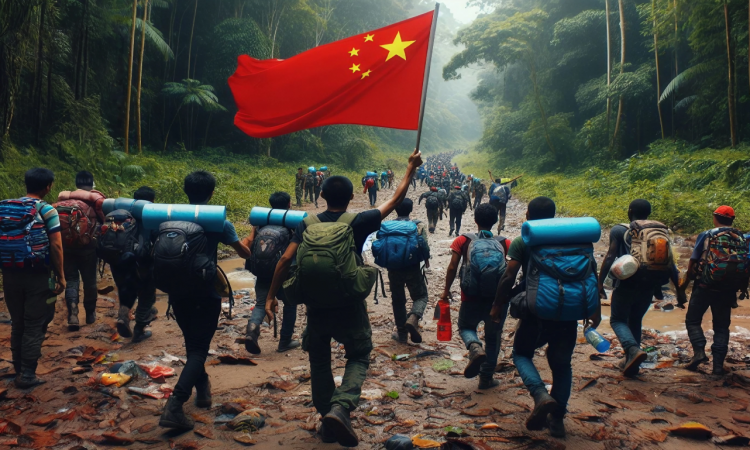Key Findings:
- In the last four months, there has been a spike in Chinese illegal immigration to the United States. The reasons for this include discontent in China regarding restrictive policies imposed since the COVID-19 outbreak and increasing youth unemployment.
- In the past two years, Chinese citizens have coined a term to describe the risky journey to get to the United States by foot: zouxian (走线). It has gained popularity and become a trending topic on social media since 2022.
- Google data shows zouxian has climbed in rankings of online searches in China. This rise has advanced despite limited access to the internet and social media due to authoritarian restrictions of the Chinese Communist Party.
Interview
Watch on YouTube | Listen on Apple Podcasts | Watch on BitChute
Overview
In addition to Latin American illegal immigrants getting to the United States, citizens from elsewhere such as Asia and Eastern Europe are increasingly crossing the US-Mexico border. Some of these nationalities include China, India, Myanmar, the Philippines, Russia, Turkey, and Ukraine. In 2023, China became the largest sender of illegal immigrants—outside of the Americas—to the United States.
According to US Customs and Border Protection (CBP) data, there has been a spike in Chinese illegal immigrants in the last four months. In October, November, December 2023, and January 2024 (fiscal year 2024), CBP officials encountered 7,163, 7,239, 8,619, and 6,778, Chinese illegal immigrants, respectively. In the same period, one year earlier, CBP officials encountered 2,281, 2,368, 2,818, and 3,147 illegal Chinese immigrants, respectively.
Out of all the CBP encounters with Chinese illegals in US territory, 87 percent are single adults. The remaining 13 percent are divided between accompanied minors, solo minors, and individuals belonging to a family.
This investigation explains the reasons, routes, and dangers Chinese illegal immigrants face on their way to the United States. The Impunity Observer reached out to three human smugglers in the Darién Gap, but they refused to specifically address the case of Chinese migrants on the Colombia–Panamá border. One of them told the Impunity Observer researcher: “Do not ask any more questions. Nobody will answer you because this is a sensitive topic.” Smugglers in this area often work for the Gulf Clan cartel.
Further, the Impunity Observer conducted a Google Trends analysis of Mandarin Chinese words to illustrate the rising interest in and popularity of illegal migration.
It Starts in Ecuador
As a result of poor border control and explicitly open border policies, Ecuador has become an attractive starting point for Chinese illegals—and other nationalities—seeking to get to the United States via Central America. There are hundreds of illegal passages (trochas) between Ecuador and Colombia, which are cheap and easy to access. Even the legal crossings often have scant protection or monitoring.
For migrants, crossing illegal passages between Ecuador and Colombia costs around US$15–20 per person. Smugglers and transnational criminal organizations have cornered this market for another income source, in addition to narcotrafficking, extortion, and assassination.
Ecuador does not require a visa for Chinese citizens who visit the country for less than 90 days. Chinese nationals, therefore, can use this opening to travel north or simply stay in Ecuador illegally. In June 2008, then Ecuadorian President Rafael Correa implemented the “open doors” policy, where the country did not require a visa for any citizen in the world who wanted to visit the country for up to 90 days. Ecuador now requires visas for 24 nationalities, including Cuba and Venezuela, presumably because overstaying became so common.
A November 2023 report by local news outlet Primicias was an early alert that Ecuador was becoming a transit point for Chinese migrants. It asserted that Ecuadorian public medical centers had registered an increase in Chinese citizens getting vaccines against yellow fever. Countries such as Colombia and Panama demand this for many people entering their territories.
Ecuadorian medical workers report that they receive around 200 Chinese citizens daily requesting vaccines, which is a relatively new and notable development. A worker claims: “[Chinese migrants] tell us that they are going to Colombia, El Salvador, or Guatemala. In these countries, the state requires them to have these shots before entering their territories.”
According to the Ecuadorian government, 39,457 Chinese citizens legally entered the country from January to October 2023. Just one year prior, that number was 9,000 Chinese citizens. Since many Chinese arrivals leave the country illegally, any migration numbers are best taken with a pinch of salt.
The few Chinese migrants lucky enough to get a Mexican visa avoid visiting Ecuador and can skip the whole trip through Central America.
Zouxian: Chinese Illegals’ Route to the United States
Getting to Colombia from Ecuador is the first step before embarking on the trip through the Darién Gap to reach Central America and eventually the United States. In the past two years, Chinese citizens have coined a term to describe the risky journey: zouxian (走线). This translates to walking the route, and it refers to traveling to South America before going to the United States by foot.
Despite limited access to the internet and social media due to restrictions by the Chinese Communist Party, Chinese citizens are increasingly interested in zouxian. A Google Trends analysis, using data from January 2022 until February 2024, shows how zouxian has gained interest from Chinese citizens in online searches.
Interest from Chinese Citizens in Online Searches

In 2023, the Impunity Observer reported how migrants from all regions—but predominantly Latin Americans, Africans, and Asians—cross the Darién Gap between Colombia and Panama before continuing their path to the United States. The risks of crossing this route include, among many, extortion, kidnapping, assault, rape, and even land mines.
The Colombian Foreign Affairs Ministry has reported that on January 1–15, local authorities encountered 1,227 Chinese migrants in Necoclí, the starting point before crossing the Darién Gap. The Chinese were the third most common nationality, behind only Venezuelans and Haitians, who had 4,750 and 1,464, respectively.
Smugglers and criminal groups dominate the illegal passages through the Darién Gap. They charge a fee to purportedly guide migrants through the jungle.
After reaching Central America, migrants tend to ride buses until they reach towns near the borders with neighboring nations. Here the migrants resort to either migrant caravans, smugglers, or self-organized trips that often include bribing local officials to cross borders.
Don Castriotti told the Impunity Observer that he has witnessed the rise of Chinese migrants crossing Central America by foot. Castriotti is president of Suffering Relief, a charity that provides migrant shelter in Trojes, Honduras, near the Nicaraguan border
Once Chinese migrants reach Mexico, they face their final challenge. In this country, coyotes charge north of $20,000 to help migrants get to the United States. The price is usually cheaper for Latin Americans, especially Mexicans.
Once Chinese migrants have crossed the US-Mexico border, they ask for asylum to formalize their presence in the country, a process that can take up to 180 days from the application. Due to a backlog of immigration cases in the United States, resolution is likely to take years. Migrants in US territory can request asylum if: (1) they are not amid a deportation process and (2) they have filed the application within one year of arriving in the country.
Why Now?
There are multiple reasons why Chinese citizens are willing to risk their lives and cross the entire world to seek a better future. In contrast to Latin Americans, who mostly leave their countries for economic opportunities, the Chinese also look for civil liberties in the United States.
In China, citizens are subject to both political repression and decreasing economic opportunities. Since the COVID-19 outbreak, the Chinese Communist Party has implemented strict lockdowns and invasive policies. These include breaking into residences and killing infected pets while the owners are in quarantine.
Further, the unemployment rate for people 16–24 years old has grown steadily since 2022. In December 2022, the unemployment rate for this age group was 16.7 percent, according to the Chinese National Bureau of Statistics. By June 2023, the rate had increased 21.3 percent.
The Role of Social Media
As with Latin Americans, social media plays a major role in helping Chinese citizens obtain information about zouxian. While access to media and the internet is limited, WeChat and TikTok (called Douyin in China) are some of the most relevant platforms. They assist with obtaining the latest insights from guides, other migrants’ experiences, and contacting the smugglers who will help with crossing the Americas.
After searching on TikTok, an Impunity Observer researcher found the contact information of multiple smugglers or coyotes. They describe themselves as guides for crossing borders safely. Migrants can send smugglers a message and then they send back their WhatsApp information. Then there can be a more straightforward and direct discussion between prospective clients and self-described guides.

Despite the smugglers’ guidance, migrants are still vulnerable when crossing borders through illegal passages. At the US–Mexico border and in the Darién Gap, there are hundreds of reported cases of smugglers abandoning migrants in the middle of their journeys. In these scenarios, migrants face the jungle, desert, and rivers while having little knowledge of the territories they are in.
Due to a lack of freedom and economic opportunities, Chinese migrants are risking their lives and handing their safety to criminal groups in Latin America. Zouxian has become popular in China, and internet interactions reflect that. Meanwhile, citizens rely on social media to find first-hand testimonies and information regarding the trip to the United States.
 Join us in our mission to foster positive relations between the United States and Latin America through independent journalism.
Join us in our mission to foster positive relations between the United States and Latin America through independent journalism.
As we improve our quality and deepen our coverage, we wish to make the Impunity Observer financially sustainable and reader-oriented. In return, we ask that you show your support in the form of subscriptions.
Non-subscribers can read up to six articles per month. Subscribe here.



